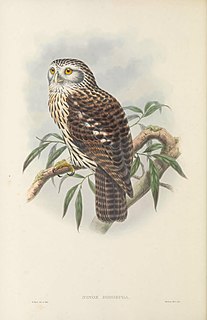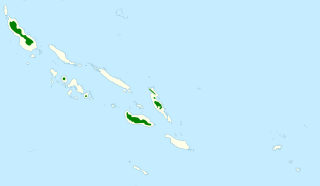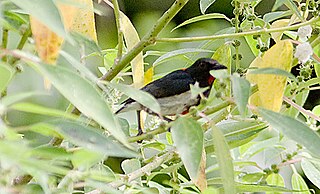
The Philippine scops owl is a common owl, endemic to the Philippines, belonging to the family of the typical owls Strigidae. Other common names include "Otus Whitehead", "Whitehead scops owl" and "Luzon lowland scops owl". Everett's scops owl and Negros scops owls were formerly considered conspecific but are now classified as subspecies of Otus megalotis.

The greater sooty owl is a medium to large owl found in south-eastern Australia, Montane rainforests of New Guinea and have been seen on Flinders Island in the Bass Strait. They have a finely white spotted head with scattered white spots on the wings. The females are lighter colored than the males. The females' length is 37–43 cm and weighs 750-1200 g. The smaller male has a length of 37–43 cm and weighs 500-700 g. The wing length is 30–40 cm. The large dark eyes are set in a round large facial disk. The facial disk is dark gray-silver or sooty black and has a heavy black edge. The upper part of the owl is black to dark gray and the under part is lighter. The tail is short and the legs are feathered. The feet and talons are large. Their call is a piercing shriek which can last up to two seconds.

The Papuan hawk-owl is a medium-sized, sleek owl with a proportionately small head, long tail, and short, rounded wings. Its white facial disk is small and indistinct, with black streaks, and white eyebrows. It has buff-colored upperparts and barred black and brown underparts. Its eyes are bright yellow, and it has a gray to black bill. The male is larger than the female, which is unusual among owls.

The WestSolomons owl, also referred to as the West Solomons boobook, is a small to medium-sized owl, measuring 23–31 cm (9.1–12.2 in) in length. Its upperparts are rusty brown, sometimes spotted or barred with white, its chest is buffy white, sometimes spotted or barred with brown, and its creamy belly is unmarked. It has a grayish-brown facial disc, edged by narrow white eyebrows and a band of white across the throat.

The New Britain boobook, also known as the spangled boobook, New Britain hawk-owl or Russet hawk-owl, is a small owl that is endemic to New Britain, the largest island in the Bismarck Archipelago in Papua New Guinea.
The speckled boobook, also called the Oriental hawk-owl, is a small owl at 17–20 cm. It is a reddish-brown hawk owl with a white-spotted head, back and wings, a white throat patch, black facial disk, and white eyebrows.

The Palawan hornbill is a large forest bird endemic to the Philippines. It is one of the 11 endemic hornbills in the country. It is only found in Palawan and nearby islands of Balabac, Busuanga, Calauit, Culion and Coron. It is locally known as 'talusi' in the language Cuyunon, It is threatened by habitat loss, hunting and trapping for the cage-bird trade.

The Palawan scops owl is an owl endemic to Philippines only being found in the island of Palawan. It is found on tropical moist lowland forest. It is threatened by habitat loss.

The Mantanani scops owl, is a small owl in the scops-owl genus Otus found on small islands between Borneo and the Philippines. It is listed by the IUCN as "near threatened" because its range is limited with its population being fragmented on several different islands, and its forest habitat is being degraded by ongoing logging and clearance.

The Christmas boobook, also known more specifically as the Christmas Island hawk-owl, is a species of owl in the family Strigidae.

The pale mountain pigeon is a species of bird in the pigeon family Columbidae. It is endemic to the Solomon Islands archipelago, where it inhabits old-growth and secondary montane forest. It is a medium-size pigeon with an average length of 38 cm (15 in) and a weight of 310–385 g (10.9–13.6 oz). The head and neck are whitish-grey, the belly and lower breast are buffy-pink, and the vent and undertail coverts are pale grey. The upperparts are smoky-grey with darker fringes on the mantle and wing coverts. Both sexes look similar, but there can be large variation in individual appearance.

The Philippine leafbird is a species of bird in the family Chloropseidae. It is endemic to the Philippines. It is found in the islands of Mindanao, Leyte, and Cebu.

The Black shama is a species of bird in the family Muscicapidae. It is endemic to the island of Cebu, Philippines where it is known locally as "Siloy".

The scarlet-collared flowerpecker is a species of bird in the family Dicaeidae, about 10 cm long and is endemic to the Philippines.

The white-throated jungle flycatcher, also known as the Negros jungle flycatcher is a species of bird in the Old World flycatcher family Muscicapidae. It is endemic to the Philippines and formerly on Guimaras before its extirpation there. The natural habitats of the white-throated jungle flycatcher are tropical moist lowland forests and tropical moist montane forests up to 1,350 masl. It is threatened by habitat loss.

The Negros scops owl, also known as the Visayan scops owl, is an owl, endemic to the islands of Negros and Panay in the Philippines, belonging to the family of the typical owls Strigidae. They were formerly classified as a subspecies of the Philippine scops owl. It is threatened by habitat loss and hunting for the pet trade.
The Mindoro hawk-owl or Mindoro boobook is a species of owl in the family Strigidae that is endemic to the Philippines.
The Romblon hawk-owl or Romblon boobook, is a species of owl in the family Strigidae that is endemic to the Philippines only found in the islands of Tablas, Sibuyan and Romblon. It was previously known as a subspecies of the Philippine hawk-owl, but was reclassified in 2012, as voice and other evidence suggested it a distinct species. Its natural habitats are r tropical moist lowland forest. It is threatened by habitat loss.
The Sulu hawk-owl or Sulu boobook, is a species of owl in the family Strigidae. It is endemic to the Sulu Archipelago in the Philippines. It was previously known as a subspecies of the Philippine hawk-owl, but was reclassified in 2012, as voice and other evidence suggested it a distinct species. It is found in tropical moist lowland forest. It is threatened by habitat loss.
Gunung Ambang Nature Reserve is a preserved area in the north of the island of Sulawesi in Indonesia. It is in a mountainous, little-explored region and contains a large number of indigenous plants and animals.















